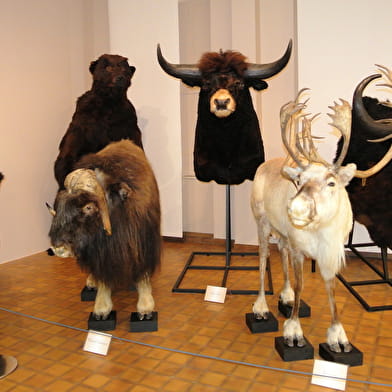
Museum d'Histoire Naturelle Jacques de La Comble
The Jacques de La Comble Natural History Museum houses over 800,000 samples representing specimens from all areas of the natural sciences. It holds the world's leading collection of fossil nodules from the continental Carboniferous (160,000 items). The Autun Natural History Museum dates back to the early 19th century. The collections built up by the Natural History Society and now owned by the town of Autun are of exceptional quality. Each year, temporary exhibitions highlight a particular theme in the permanent collections. In its reserves, the Autun Museum holds naturalised specimens, including a collection of birds, eggs and nests representing over 10,000 specimens, as well as insects (over 100,000). Herbaria (over 300,000 plates) contain plants from all over Europe and even from North Africa, collected as early as the 19th century. A huge number of minerals tracing the geological history of the region.
Tens of thousands of fossils representing animals and plants that lived in our region between 300 and 275 Ma. The Autun basin is a world reference in the history of the Earth for a period of the primary era. This is known as the stratotype. The fossils in the museum's collections bear witness to this. You will also find a sample of the collections held in reserve on prehistory in the Autun basin during the Mousterian (90,000-35,000 years ago) and Neolithic (5,000 years ago) periods. Fossil animals from the Carboniferous at Blanzy-Montceau les Mines-Le Creusot (300 million years ago) Fossil flora and fauna in the Autun basin (295 to 275 million years ago)
Energy routes, the history of an industrial sector: this is organised around bituminous shales, enabling the production of shale oil, the equivalent of natural petroleum, coal and autunite, France's first uranium mineral. Traces of the first Morvan dinosaurs The mineralization characteristic of the Morvan mines and quarries, exploited to supply the steel and aluminium manufacturing industries with fluorite.
Animals of the Far North (elk, reindeer, Siberian tiger, silver fox, white fox, blue fox, wolverine, etc.).
The ornithology room with the exhibition "The Art of Being a Bird".
PRM access via rue Saint-Antoine.
- French
- Credit card, Payment cards, Cheques and postal orders, Cash, Visa
- Pets not allowed
- Film projection room
- Toilettes
- Library
- Specific theme activities
- Junior workshop
- Specialist conferences
- Conferences
- Temporary exhibitions
From 02/04/24 to 30/09/24 of 14:00 to 18:00 - of 10:00 to 13:00.
Closed on : Monday
From 01/10/24 to 31/12/24.
Closed on : Monday, Tuesday
Open from 02/04/2024 to 30/09/2024 from 10am to 1pm and from 2pm to 6pm. Closed on Mondays, and occasionally on public holidays: 1 and 8 May.
Open from 01/10/2024 to 31/12/2024 from 10am to 1pm and from 2pm to 5pm. Closed on Mondays, Tuesdays and occasional public holidays: 01/11/2024 and 11/11/2024 and 25/12/2024.
- Child rate (Free for under 18s)
- Special rate (Reduced rate: for groups of 15 or more, disabled people, jobseekers, etc. Please ask the Museum for details.) : 3€
- Student's rate (Free for students under 26, on presentation of proof of age)
- Other rate (Entrance fee) : 5€
Distancing, mask, hydro-alcoholic gel, signposted route, limited number of visitors in the exhibition rooms

Brochures Bourgogne Tourisme
Consult our brochures online or order them to receive at home






